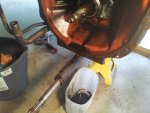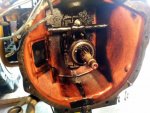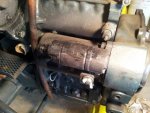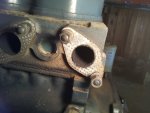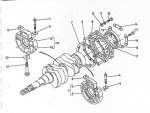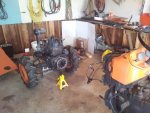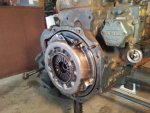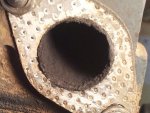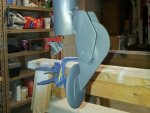New Kubota owner who is using mechanical ability and the internet as a stand in for mechanic experience (which I have none).
I bought a grey market L1801DT with 850hrs. Seller told me the clutch needed replacement. I could operate it fine, but the clutch tended to jump into motion no matter how slow you came off it. So his explanation made sense.
I bought the tractor in the late fall, when I got it home, I expected it to leak oil as there was so much oil on everything. I degreased the engine and washed it down to see if I could get an idea where it was coming from. I did not run it that much before storing for the winter. I expected it to leak and put cardboard down, but it didn't at all.
In the spring I got it running and ran it around a bit and then decided to do the recommended "new to me change" of all the fluids and filters. Since I was doing the full fluid and filter replacement, I decided to split it and do the clutch while the transmission was empty of oil.
Drained all the fluids, and split the tractor. Oil started coming out of the bell housing as the halves came apart. With better access to all the engine parts I started to notice that there was a lot of gunked-up oil on the engine. lots sludge on the shaft sleeve that runs up to the front wheels and on the starter motor.
With the tractor apart I could see into that oil was sprayed around the bell housing (see picture).
I think I have a leak in the from transmission, (possibly engine?) into bell housing. I have done searches through OTT forums and this sounds reasonable based on my observations.
Since I have the tractor spilt I cant' really do some of the diagnosis suggested in other posts. I can't spray in brake cleaner and leave the drain nut out and see what I get after running the tractor. The oils are drained so is leak is not going to be evident. Based on the excessive sludge everywhere (from longer term accumulation?) I dont' think this was a oil leak produced by steep incline/decline or over fill of transmission -- it has been ongoing.
Question is... what do I do next?
Can I provide more information that can help the actual mechanics on this forum with enough to diagnose the source of my problem?
Since the tractor is split, should I just replace seals and o-rings? If so which ones?
Is it possible that my clutch is fine and it was the oil that was making it jump? If this is a possibility, is there any way to determine if I should continue using my current clutch? Should I switch it out since I have it sitting in a box and my tractor is in two pieces.
Lastly, I will throw in one more picture of the exhaust port after removing the manifold which needed a new gasket. Lots of black build up on both ports. I have no idea if this is normal or otherwise.
Thanks for any advice you can give.
I bought a grey market L1801DT with 850hrs. Seller told me the clutch needed replacement. I could operate it fine, but the clutch tended to jump into motion no matter how slow you came off it. So his explanation made sense.
I bought the tractor in the late fall, when I got it home, I expected it to leak oil as there was so much oil on everything. I degreased the engine and washed it down to see if I could get an idea where it was coming from. I did not run it that much before storing for the winter. I expected it to leak and put cardboard down, but it didn't at all.
In the spring I got it running and ran it around a bit and then decided to do the recommended "new to me change" of all the fluids and filters. Since I was doing the full fluid and filter replacement, I decided to split it and do the clutch while the transmission was empty of oil.
Drained all the fluids, and split the tractor. Oil started coming out of the bell housing as the halves came apart. With better access to all the engine parts I started to notice that there was a lot of gunked-up oil on the engine. lots sludge on the shaft sleeve that runs up to the front wheels and on the starter motor.
With the tractor apart I could see into that oil was sprayed around the bell housing (see picture).
I think I have a leak in the from transmission, (possibly engine?) into bell housing. I have done searches through OTT forums and this sounds reasonable based on my observations.
Since I have the tractor spilt I cant' really do some of the diagnosis suggested in other posts. I can't spray in brake cleaner and leave the drain nut out and see what I get after running the tractor. The oils are drained so is leak is not going to be evident. Based on the excessive sludge everywhere (from longer term accumulation?) I dont' think this was a oil leak produced by steep incline/decline or over fill of transmission -- it has been ongoing.
Question is... what do I do next?
Can I provide more information that can help the actual mechanics on this forum with enough to diagnose the source of my problem?
Since the tractor is split, should I just replace seals and o-rings? If so which ones?
Is it possible that my clutch is fine and it was the oil that was making it jump? If this is a possibility, is there any way to determine if I should continue using my current clutch? Should I switch it out since I have it sitting in a box and my tractor is in two pieces.
Lastly, I will throw in one more picture of the exhaust port after removing the manifold which needed a new gasket. Lots of black build up on both ports. I have no idea if this is normal or otherwise.
Thanks for any advice you can give.
Attachments
-
58.3 KB Views: 958
-
76 KB Views: 755
-
68.6 KB Views: 650
-
54.6 KB Views: 619


